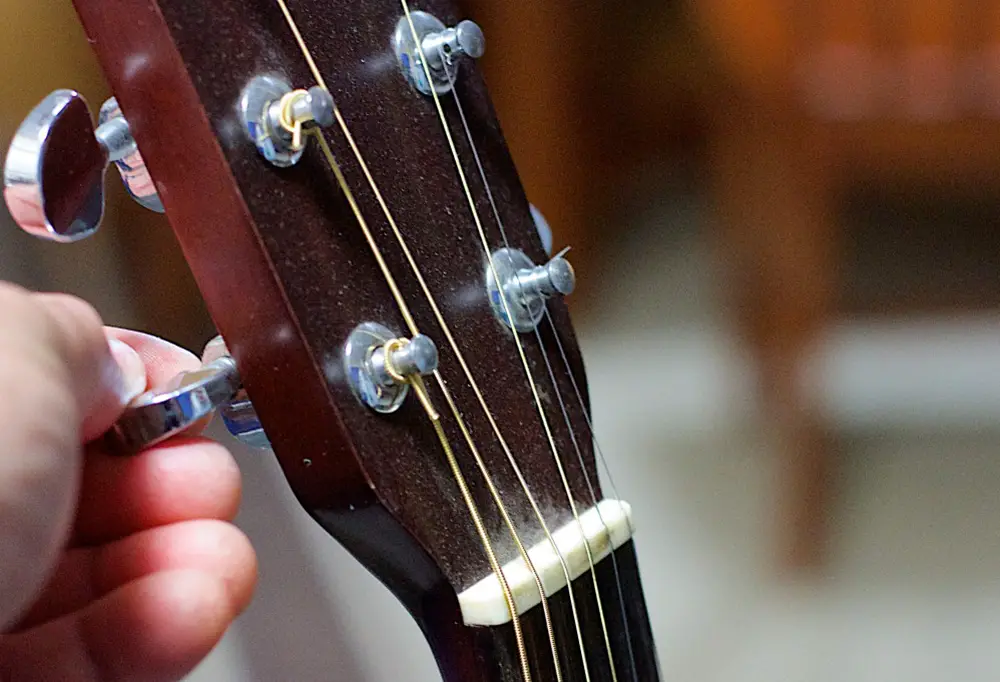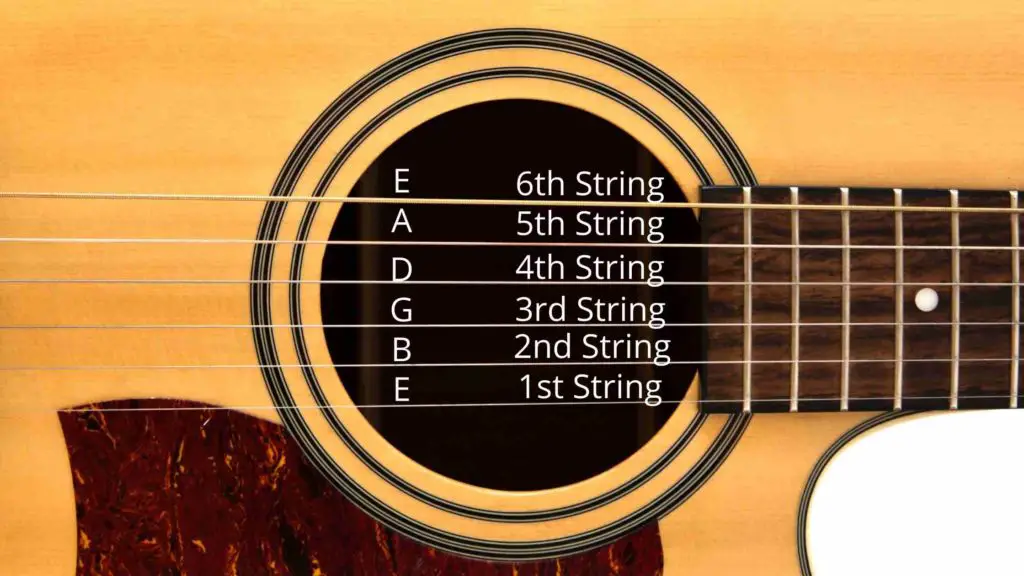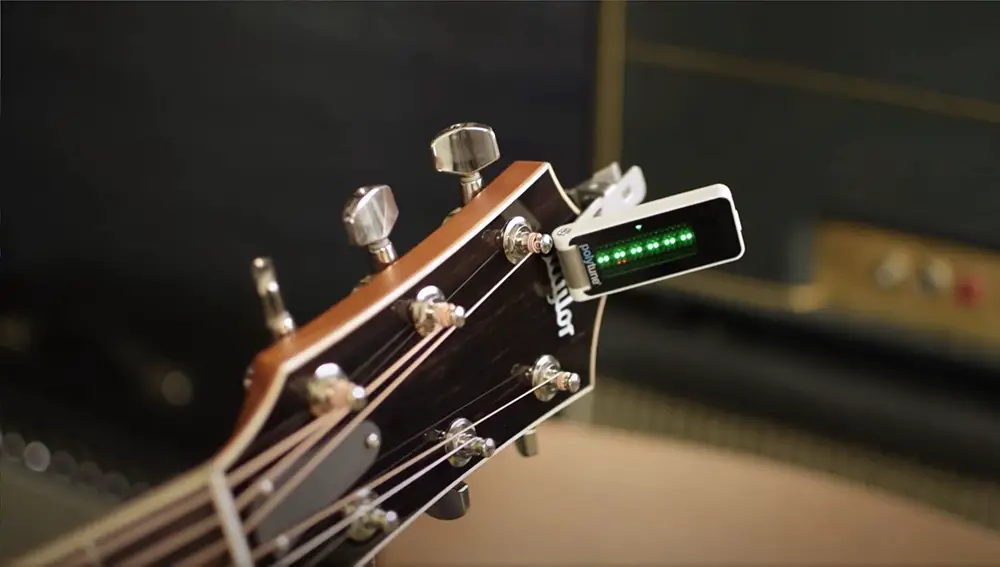Tuning is a necessary skill to master as a guitar player, and it takes time to perfect. Beginners should purchase a guitar tuner so they can make the instrument sound as wonderful as possible, both for themselves and any other person who has to listen to them practice!
Whatever tuner you use, you’ll be using the same basic tuning technique.
To tune a guitar, you will play each string individually, check its tuning, and adjust it as needed. Once each string is checked, go through the strings again to fine tune each one and check that they are all in tune.
I’ll walk through the steps in tuning your guitar, and then you can read the instructions on how to apply this method with the different types of tuners.

Steps to Tune a Guitar:
Check the String’s Tuning
Start by tuning the low E String, assuming you are using a standard 6-string guitar. The low E string is the thickest string and will be the one on top when you are holding the guitar in a playing position.
After picking the string, check your tuner to see whether the string is too high (sharp), too low (flat), or in tune.
If the string is in-tune, move on to the following string. Otherwise, go to the next step to adjust the tuning.
Adjust the String’s Tuning
Turn the tuning peg for the respective sting to adjust the pitch and bring the string into tune.
If you don’t hear any change in pitch, make sure you’re turning the correct tuning head. You may snap a string if you don’t realize you’re turning the wrong tuning head.
The direction you need to turn the tuning head depends on the type of guitar and headstock, but it won’t take you long to figure out which way raises or lowers the pitch.
Tip: Try loosening the string slightly to make it flat before tightening it up to the proper pitch. This will make tuning easier because the string may not completely relax when you try to flatten the note, causing the string to jump later on and become out of tune.
Go Through Each Guitar String
Once the low E string is in tune, move on to the A string and repeat the previous step on that string.
Continue through all strings and bring each one into tune.
Re-check and Fine Tune All Strings
When you finish tuning all of your strings, go back and check the tuning of all of them again.
You may find that some of the strings have slipped slightly out of tune.
This happens due to the change in tension across the neck, the difference in tension on the strings, and the type of bridge your guitar uses.
The tension on the neck is the same reason we start with tuning the low E string. The low E string is the largest string and will have the biggest impact when adjusting it.

Guitar Tuning Basics
Standard Tuning
The most common tuning you will use on an acoustic or electric guitar is called Standard Tuning.
Standard Tuning tunes the six strings on a guitar (from thickest to thinnest) to the pitches: E A D G B E.
Here are two helpful mnemonics to assist you in remembering the order of the notes that each string is tuned to:
- Elephants And Donkeys Grow Big Ears
- Eddie Ate Dynamite Good Bye Eddie
Make up your own or pick whatever you like best. The more ridiculous, the better! That makes it easier to remember.
Alternate Tunings
There are a lot of different tunings for the guitar, which we call ‘Alternate tunings’ when it’s anything other than standard tuning. I’ll cover two of the most popular: Drop D and Eb.
Drop D Tuning
Drop D tuning is one of the most popular ways to tune your guitar, and it’s one of the easiest alternate tunings to learn. You can hear it in many famous rock and metal songs.
It changes the pitch of just one string, the low-E string. Adjust the pitch of your low E string down a whole step, taking it down to a D.
In Drop D tuning, your strings would be tuned as follows:
— D (lowest string)
— A
— D
— G
— B
— E (highest string)
Eb Tuning
Eb Tuning is simply tuning every string down a half step.
It makes the strings ever so slightly looser, so bends are a little easier. Also, it’s slightly lower, so it’s better for some singers.
Eb tuning was popular with rock bands back in the day. A song most of us have heard, Guns N Roses – Sweet Child O’ Mine, was recorded in Eb tuning. In fact, most of Guns N Roses songs were played in this tuning.
In Eb tuning, your strings would be tuned as follows:
— Eb (lowest string)
— Ab
— Db
— Gb
— Bb
— Eb (highest string)
Tip: Be aware that some tuners only show sharps and no flats, so you might be looking for D#, G#, C#, F#, A#, and D# if that is the case.

How to Tune an Electric Guitar With a Tuner Pedal or Multi-Effects Pedal
Tuning your guitar using a tuner is my recommended method for all players, from beginners to advanced. Don’t be under the misconception that all pro players use their ears only – it’s something most players should be able to do; however, using a tuner is accurate and easy and is always the first choice!
Secondly, you can tune your guitar in the middle of a song quickly if needed.
Whether you use a tuner pedal or the inbuilt tuner in a multi-effects pedal or a guitar amp, the method for tuning your guitar is basically the same.
- Plug your guitar into the input jack.
- Turn on the tuner
- Turn up the guitar volume to 100%
- Pluck each string and adjust it as needed until it is in tune.
Most pedals or inbuilt amp tuners will light up in a different color (usually green) or show something to let you know when the string is in tune.
Most tuner pedals will mute your guitar signal during tuning, so remember to disengage the tuner when you are all tuned up to start sending your signal to the output again.
How to Tune a Guitar With a Clip-on Tuner
I highly recommend the clip-on type.
- You don’t have to be plugged in,
- They work on all stringed instruments,
- they’re close and easy to read, and
- they’re very portable.
One of my favorites is the TC Electronic Polytune clip-on tuner; it’s super accurate, well built, and easy to use.
You can use a clip-on tuner to tune electric or acoustic guitars. The tuner works by sensing the vibration in the guitar so that you can use it in any environment on almost any guitar.
A guitar can be tuned by clipping the tuner onto the guitar’s headstock. Adjust the screen so you can clearly see it while playing and turn it on. Pluck each string and adjust it as needed until it is in tune.

How to Tune an Electric Guitar Without an Amp
It can be difficult to tune a guitar without an amplifier if you have never done it before. Guitarists should always tune their instruments before playing. Luckily, there are many ways of tuning a guitar without an amplifier.
An electric guitar can be tuned by plugging directly into a tuner or using a clip-on tuner. Tuning by ear or using a smartphone tuning app is an option in a quiet enough setting.
While an unplugged electric guitar is far quieter than an acoustic guitar, it still emits a sound. So you can still use any tuner that has an inbuilt microphone if you’re in a calm environment.
How to Tune a Guitar Without a Tuner (Using a Piano or Other Reference)
Keep in mind that you get the best results when using a tuner. I highly recommend that guitarists get a tuner. When your guitar is in tune, it’s a lot more exciting to play, and it actually sounds good. But if you don’t have a tuner available, here is what you can do.
A guitar can be tuned without a tuner using a reference pitch, such as a piano or other in-tune instrument. Listen to the pitch of the other instrument, and adjust the respective guitar string until it is at the same frequency.
This will take practice to perfect, but trust me, you’ll get better over time.
There are many tools that can be used: Tuning forks, pianos, pitch pipes, etc. Anything that is capable of producing the correct pitch can be used to help tune the guitar.
I’ve only seen it once in my life, but if you have perfect pitch, you can listen to the note and know if it is at the correct frequency or not. Perfect pitch is extremely rare, with an estimated 1 in 10,000 people capable of this skill.
Types of Guitar Tuners
If you’d like to know more about tuners, check out my article:
Which Tuner Is Best For An Electric Guitar?
The best tuner for an electric guitar is one that has an input port that the guitar can be plugged into. Having the guitar plugged in results in increased accuracy when tuning. Clip-on tuners are a good option if you cannot plug in the guitar.
The signal is transmitted straight from the guitar’s pickups, which makes plug-in tuners generally the most accurate of tuners. Plug-in tuners are usually true bypass, so the signal will not be altered or enhanced.
Another benefit of having a pedal tuner is that it also mutes your guitar signal and allows you to tune quietly. It completely mutes your guitar signal and allows you to tune without making any noise.
It may take some practice to figure out how to tune without hearing the instrument by just doing it visually, but it won’t take long until you get it figured out.
TC electronic is manufacturing some great Polyphonic tuners. Here are a few good types, depending on what you want.
Tuning Tips For Electric And Acoutic Guitars
To sound good, it’s critical to be in tune. By following these tips, you will immediately sound better.
Changing the tuning on one string can change the pitch of the other strings, owing to the altered or reduced tension it creates on the neck and other areas of your guitar.
- Tune the Low E String First -The sixth string, or low E, has the most tension. Changing the tuning on one string can change the pitch of the other strings because of the added or decreased tension it creates on the neck.
- Always Tune Up – Each string should be tuned down slightly and then raised again to the correct pitch. Adding tension rather than removing tension helps keep the string from ‘jumping’ and will help keep it in tune.
- Wait Until the String Settles – When you pluck a string, the pitch rises at first, then settles into the actual note you’re playing. The tuner will react to the first sound it detects. Play the string, let it stabalize for a second, then read what the tuner says after that.
- Keep It Quiet – For a tuner that uses a microphone, limit the surrounding noise. The tuner can’t tell the difference between the notes on your guitar and those it picks up from other noises and instruments.
- Use the Neck Pickup – Adjust Your Pickup Switch to select the Neck pickup and turn the tone knob all the way to 0. The neck pickup provides a stronger fundamental tone, which is the note that the tuner needs
- Mute the other strings – Pluck the one string you are tuning with your thumb and use your other four fingers to mute the other strings.
- ACOUSTIC TIP: Keep It Close – Keep the tuner as near to the sound hole of the guitar as possible. Keep the microphone aimed toward your guitar so that the sound of the strings are what it picks up the loudest.
- Weather and temperature matter – Guitar strings stretch and shrink when exposed to heat and cold. Tune your guitar where you will actualyl be playing it. Avoid leaving your guitar in extreme temperature conditions. If you do, give your guitar time to adjust to the new temperature once you move it, and make sure you retune before you start playing again.
Guitar Tuning FAQ
What is the Best Tuning for Electric Guitar?
The best tuning for electric guitar is standard tuning; E A D G B E. This is the best tuning because it is the standard and will allow you to play the most songs. Standard tuning is what most guitars lessons are based on, including learning scales.
Now, if you’re asking what the best sounding tuning is, the answer might be different. Drop D, Open G, and D-A-D-G-A-D are all pleasant-sounding tunings but will require a particular skill set to use.
Do You Tune an Electric Guitar the Same as an Acoustic?
Both electric and acoustic guitars can be tuned the same with Standard Tuning or any alternate tuning. While acoustic and electric guitars may feel different to play, they are tuned the same.
Electric guitars use the same tuning as acoustic guitars. Usually, electric and acoustic guitars are tuned to Standard tuning. E-A-D-G-B-E. Electric and acoustic guitars are both tuned using the tuning pegs on the head of the guitar.
How Do I Know if My Guitar is Tuned?
Use a guitar tuner to check if your guitar is tuned. A guitar tuner can tell you which strings are in tune and which ones aren’t. When you play guitar, a good guitarist will be able to know if the guitar is in tune by how the chords sound.
How Often Do Guitars Need to be Tuned?
All guitars will slowly go out of tune over time and must be regularly tuned. How often you tune your guitar depends on how often you play, how aggressively you play, and the type of hardware your guitar uses. It’s best practice to check and tune your guitar every time you pick it up to play.
It only takes less than a minute to check if your guitar is in tune, plus it’s a lot more fun to play a guitar when it is in tune. So please make it a habit to check your guitar’s tuning every time you pick it up.
Do Guitars Come Tuned?
Most guitars will come tuned from the factory or store. But you should expect the guitar to slip out of tune during transport. It’s best practice to check your guitar’s tuning when you get it home and retune it if needed.
How Much Does it Cost to Get Your Guitar Tuned?
Tuning a guitar is simple and free. The best method is to use a tuner, but a guitar can also be tuned by ear.
Unlike tuning a piano, which has a lot more string making it more difficult to tune, it is easy to tune a guitar.
If you take my advice and use a tuner, it will only cost a few bucks. You can also use a free tuning app on your smartphone. Your guitar will regularly go out of tune.
Some guitar stores offer a ‘tune-up’ service covering more than just tuning. A tune-up will usually take a closer look at the guitar and inspect its action, intonation, truss rod position, among other things.
Is It Bad to Tune Your Guitar a Lot?
It is not bad, wrong, or harmful to tune your guitar a lot. It is essential you only play guitar when it is in tune, so you need to tune your guitar regularly. Some guitars will fall out of tune faster than others, so it’s okay if you need to tune your guitar a lot.
It is recommended that you tune your guitar every time that it is played.
If you regularly change to different alternate tunings, you’ll find that your guitar goes out-of-tune all the time due to changes in neck tension. This isn’t bad for the guitar, but it can be annoying for you.

